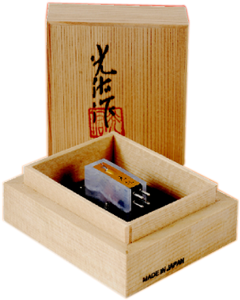
While I live in a society that covets objects in various ways, there has always been a certain consumer market that never interested me: the jewelry world. It’s not really a feminist gesture on my part that I don’t find expensive jewelry appealing, I simply don’t find it exciting to buy a shiny piece of stone or metal for hundreds or thousands of dollars and it have a circumference of only 2 cm.
But as a turntablist, there is something about a well made, quality product (a turntable, needles, sound systems) that really gets me excited. One of these products isn’t that far of a stretch from the jewelry world and the product costs just as much. It’s the Koetsu cartridge from Japan. I feel like when I type the name, Koetsu, angels should sing for a second or 2 because these needles are INSANE.
For those that aren’t familiar with this world but can relate to my excitement about an object, cartridges are needles for turntables. The needle is an interesting little object that holds the world of recorded sound in its hands. Needles are transducers—they turn one form of energy into another but all cartridges aren’t created the same. Since the dawn of the gramophone player, companies have been trying to better the needle/cartridge technology into the ultimate listening experience.

The Koetsu needle, introduced to America back in the late 1970s, was offered to the hi-fi market for $800 EACH at that time. It took huge balls for an audio company to offer a hi-fi product of this price range but the needle immediately became recognized as a cartridge that not only surpassed quality levels of the past but also changed the quality of the cartridge market as a whole.
The story of Koetsu’s Master Craftsman, who created the genre of true high-end phono cartridges, is one of 20th Century legend with a splash of ancient Japanese culture. Yoshiaki Sugano, who passed away in 2002, began as a traditional swordmaker, later becoming an executive for Toyota & Ford. Apparently, he was also an avid music lover and utilized the lessons learned from repairing swords to create his own cantilevers for needles. A cantilever is the tiny part of the needle that carries a permanent magnet that essentially reads the vibration of the record, turning it into an electric signal that is then heard as sound by us.
Koetsu needles, named for the 17th century Japanese medieval artist Honami Koetsu, who Sugano is a descendant of, have now become known for their distinct sound quality. Each needle is built individually, and checked for it’s sonic quality on a vintage Garrard 401 (considered by many professional hi-fi reviewers as one of the best turntables in the world) and fitted with an arm of Sugano’s own design. Today’s Koetsu needles are hand-built by skilled artisan Fumihiko Sugano, his son.
The Koetsu price range starts at $2500 for a cartridge made of rosewood and goes up to the $20,000 for a cartridge entirely made of Blue Lace Onyx and Platinum. Part of its unique design features a cantilever (see above) made entirely of diamond! DIAMONDS!!!
The sound quality is unsurpassed with creative use of natural materials like Jade ($8,800.00) Tiger’s Eye (AH MAH GAH!!! $13,000), Coralstone ($15,000) and lacquered rosewood of various finishes. I often get asked what my dream companies would be to collaborate with and I start talking about these damn Koetsu needles (SPONSOR ME!!!).
One aspect of my sound work requires me to find interesting sounds when things start to break, and breaking needles are a normal way of life for me. I must admit that I have had many fantasies about what it would be like to have 3 of these Koetsu needles in a “marry, boff, kill” situation. What would it sound like if I could just break one?
From the main Koetsu dealer in America: “Koetsu materials go through the most rigorous testings for purity and musical quality. Its legendary hand wound coils and meticulously carved stone and wood bodies, transcend the boundaries of art and science.”
You had me at Koetsu. The true jewelry of the turntablist.

